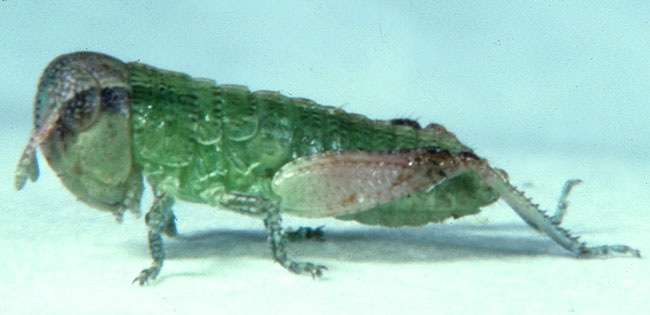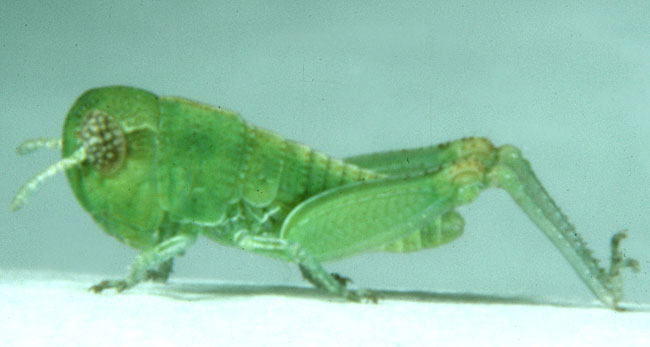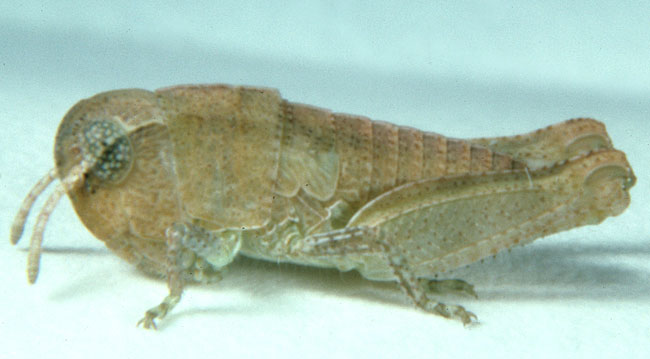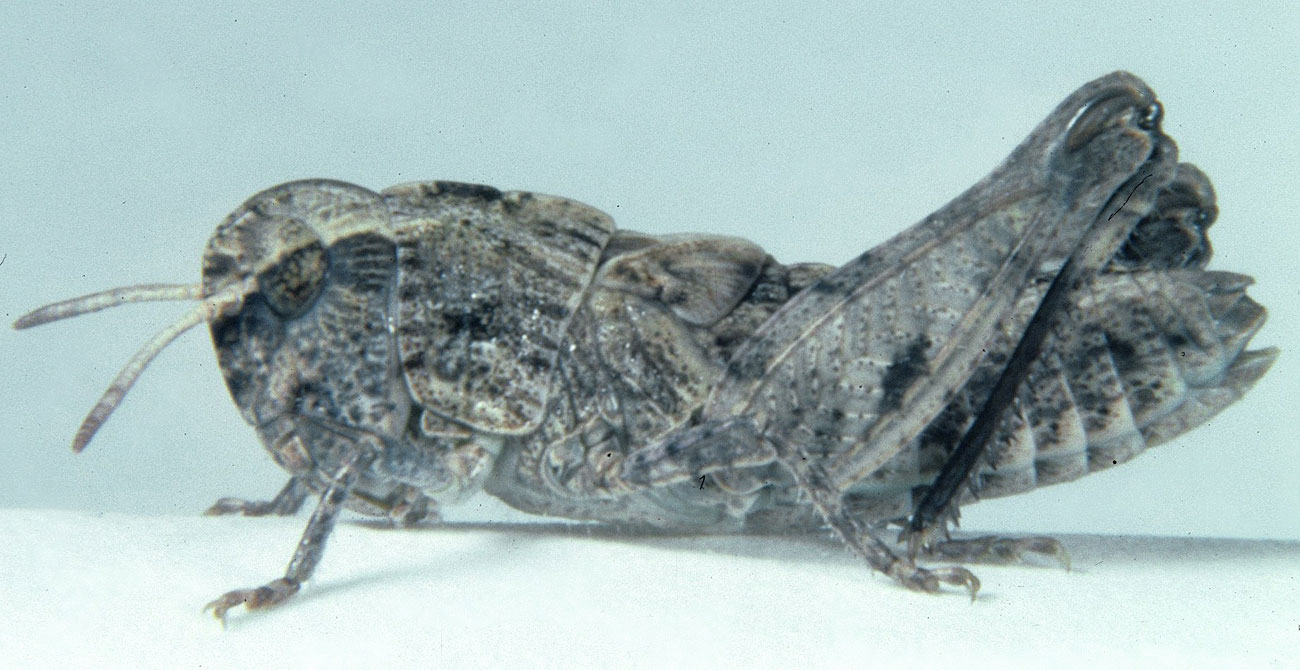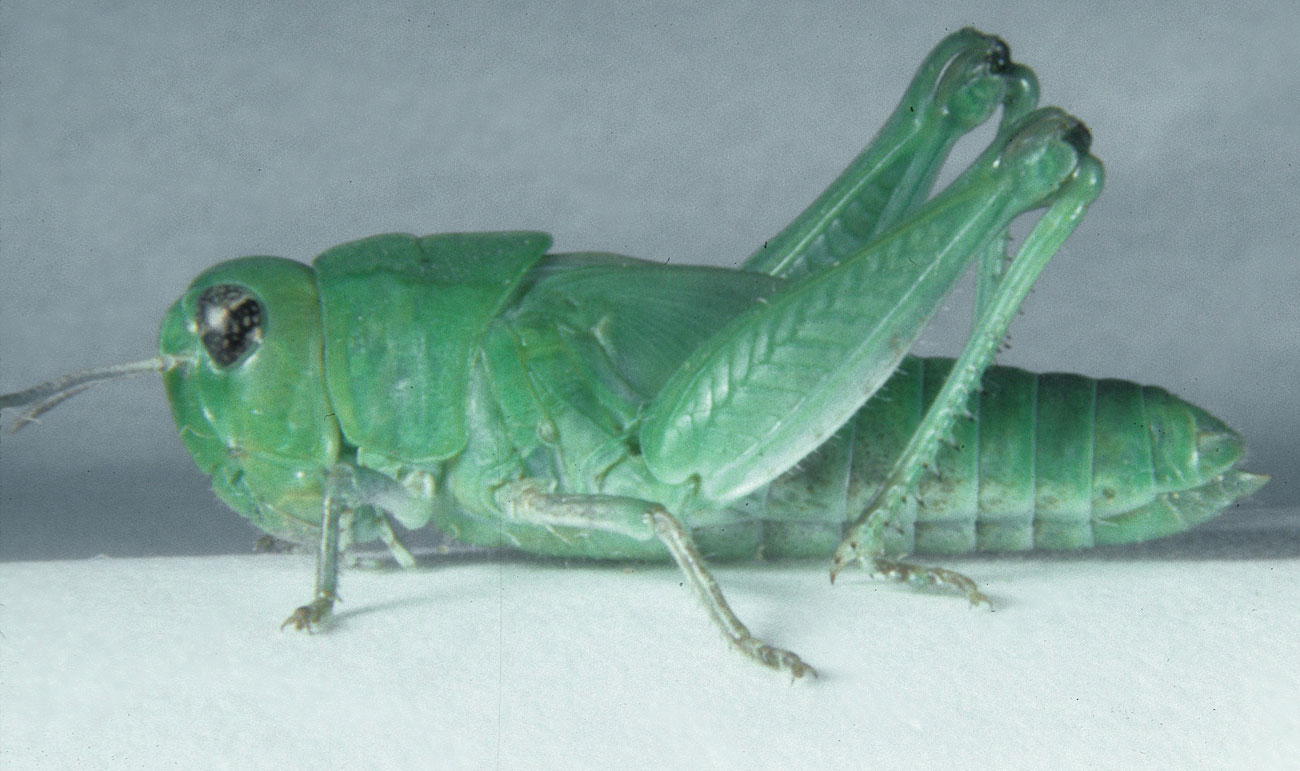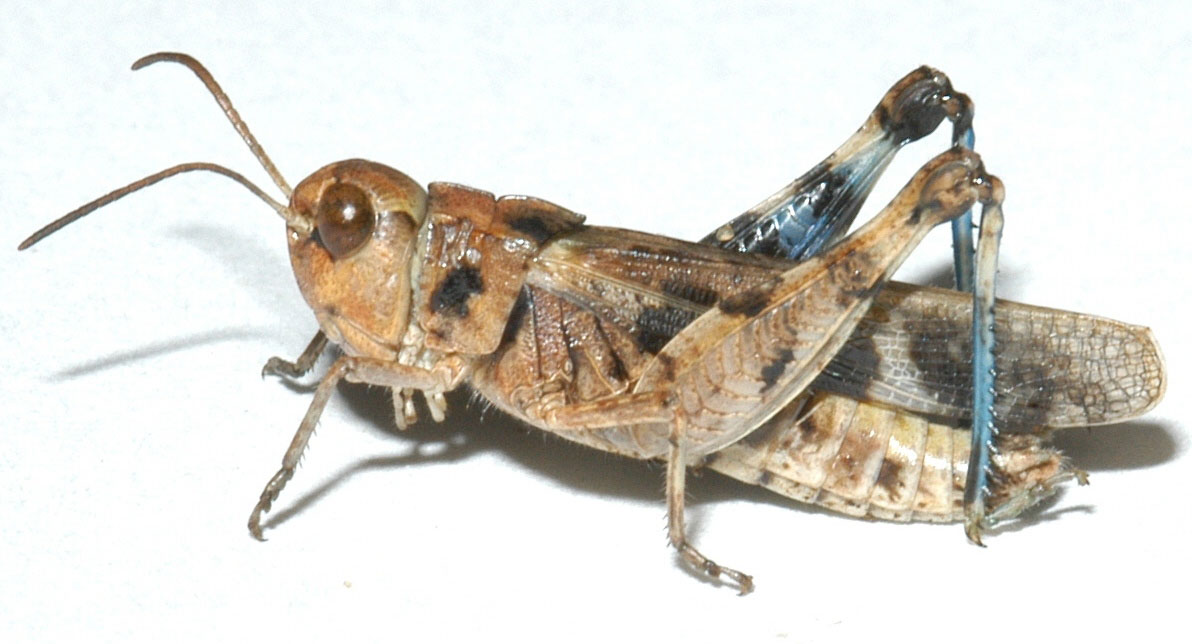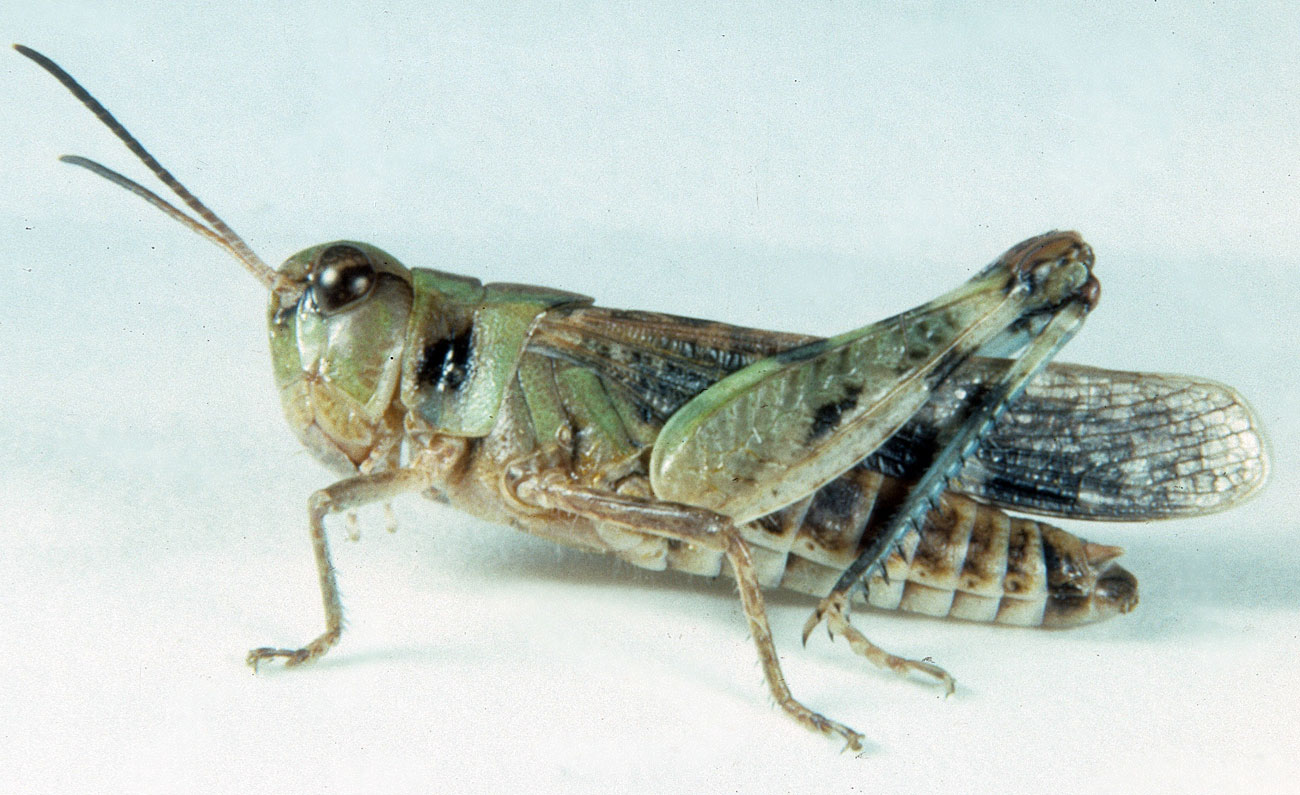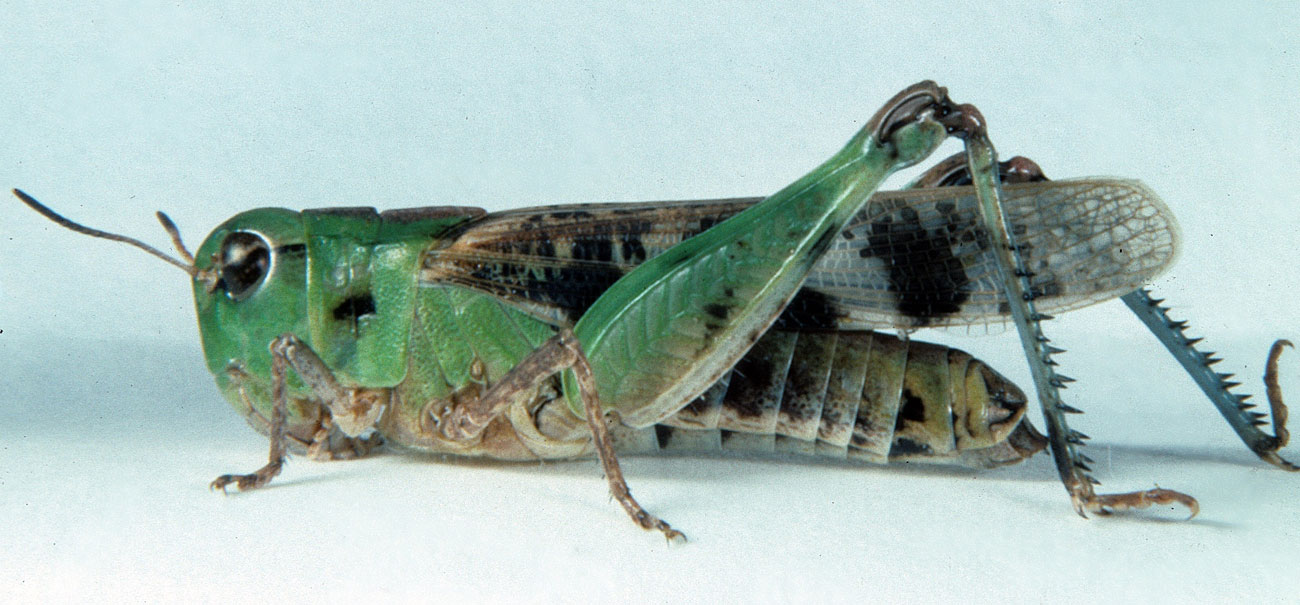Encoptolophus costalis
|
Geographic range of Encoptolophus costalis (Scudder) |
|
Fig. 1, first instar: BL 4.5-4.7 mm, FL 2-2.2 mm, AS 11-12 |
|
Fig. 2, second instar: BL 5.2-6.9 mm, FL 2.9-3.5 mm, AS 13-16 |
|
Fig. 3, third instar: BL 6.7-8.2 mm, FL 4-5.3 mm, AS 16-18 |
|
Fig. 4, fourth instar: BL 10.1-13.7 mm, FL 5.5-7.2 mm, AS 20-23 |
|
Fig. 5, fifth instar: BL 10.7-16 mm, FL 7.3-9.3 mm, AS 23-25 |
|
Fig. 6, adult male: BL 15-18.5 mm, FL 9.5-11 mm, AS 24-25 |
|
Fig. 7, adult male, green form: BL 15-18.5 mm, FL 9.5-11 mm, AS 24-25 |
|
Fig. 8, adult female: BL 21.5-25.5 mm, FL 11.5-14 mm, AS 23-26 |
|
Fig. 9, green form of adult |
|
Fig. 10, spread wings of female |
|
Fig. 11, egg pod and exposed eggs (bottom of pods at right) |
Species
Dusky grasshopper
Encoptolophus costalis (Scudder)
Subfamily Oedipodinae
Identification
The dusky grasshopper is a medium-sized, dark brown, sometimes greenish species with long wings that extend 1 to 4 mm beyond the end of the abdomen (Fig. 6-9). The tegmina are banded and the hind wings have weak apical dark bands. Occasionally these bands are dark and distinct (Fig. 10). The fastigium is distinctly longer than wide in males and ranges in females from slightly to distinctly longer than wide. The outer surface of the hind femur has three dark bands and the knee is dark. The hind femur of green specimens may have only weak bands or none at all. The hind tibia is blue.
The nymphs are identifiable by their structures, color patterns, and shape (Fig. 1-5).
- Head. Face moderately slanting; antennae short and weakly clavate (club-shaped) in instars I to III, filiform in instars IV and V, compound eyes brown with pale tan spots, light line runs from base of antennae diagonally across middle of eye.
- Pronotum with distinct median carina and plainly evident lateral carinae, disk sloping but not tectate; in green individuals usually a reddish brown to purple band runs down middle of pronotum and continues onto mesonotum, metanotum, and abdomen.
- Hind femur with outer medial area green, tan, or grayish brown; instar I with medial area often pink in distal half. Tibia and femur of fore- and midlegs carinate (ridged) longitudinally; four ridges visible on outer face, often with black lines between the ridges.
- Body color green, tan, or grayish brown.
The early instars (I to III) of the dusky grasshopper and of Chortophaga viridifasciata appear similar; both are usually green and structurally similar. They may be separated by a few characteristics that differ. The antennae of the dusky grasshopper are clavate while those of C. viridifasciata are ensiform. The outer faces of the femur and tibia of the fore- and midlegs of the dusky grasshopper have four distinct longitudinal ridges, which usually have black lines between them. Those of C. viridifasciata have two distinct ridges, which are the upper and lower carina, and a third weak ridge between them with no black lines between the ridges. Instar I of the dusky grasshopper has the medial area of the hind femur pink in the distal half, and that of C. viridifasciata is entirely green. Instars IV and V are identifiable by the shape of the pronotum. The disk of the dusky grasshopper slopes moderately, and that of C. viridifasciata is tectate (steep roof-like); the posterior angle of the disk in the dusky grasshopper is obtuse, and that of C. viridifasciata is acute.
Distribution and habitat
The dusky grasshopper ranges widely in western North America from Canada to Mexico. The species inhabits several kinds of grasslands including the mixedgrass, shortgrass, bunchgrass, and desert prairies. It is most abundant in the northern mixedgrass prairie, and is the dominant species on certain rangelands of Saskatchewan. There it favors moist areas of rich grass and sedge growth interspersed with bare ground. In its southern distribution, mesic swales and roadsides dominated by western wheatgrass and prairies with Houston black clay soil dominated by Texas needlegrass afford favorable habitats.
Economic importance
The dusky grasshopper is a rangeland species that feeds on native grasses and sedges. In the assemblage of grasshoppers inhabiting a grassland site, it is usually a subdominant member that does little damage by itself but adds to the damage of more serious pests. Occasionally, in habitats favorable to the species, it becomes the dominant grasshopper. In the Matador site of the International Biological Program (northern mixedgrass prairie in southwest Saskatchewan), the dusky grasshopper was the dominant species, making up as much as 74 percent of the grasshopper population. The density, however, was low, with approximately 2.5 young adults per square yard. Estimates made from meticulous laboratory studies of food consumption suggested that in the field the population of grasshoppers ingested 2.4 percent of annual production of grass in 1968 and 1.5 percent in 1969. There was a lack of apparent damage to the vegetation such that the rather small population of grasshoppers had no great impact on the standing crop of grasses.
The dusky grasshopper has been reported as a minor pest in alfalfa in Arizona and North Dakota and as a pest in fall wheat in Nebraska. In the latter case, adults migrated from depleted rangeland into the adjacent wheat crop.
The dusky grasshopper is a medium-sized species with marked sexual dimorphism in body size. Live weight of males averages 168 mg and of females 468 mg (dry weights: males 50 mg, females 135 mg).
Food preferences
The dusky grasshopper in its prairie habitat feeds on grasses and sedges. Western wheatgrass and needleleaf sedge are its principal host plants. Other plants eaten in substantial quantities include northern wheatgrass, needleandthread, green needlegrass, and blue grama. Analyses of crop contents of grasshoppers collected in Colorado, Kansas, North Dakota, and Saskatchewan reveal that eight additional grasses and one sedge are consumed in variable amounts: quackgrass, prairie junegrass, sand dropseed, little bluestem, sideoats grama, Kentucky bluegrass, foxtail barley, timothy, and Penn sedge.
In an unusual habitat, such as an alfalfa field or a roadside, the dusky grasshopper may feed on a mixture of forbs and grasses. Of 52 specimens collected from an alfalfa field in North Dakota, 30 had ingested alfalfa. In laboratory tests, starved individuals limited to single food plants fed well on certain forbs and refused others. Well-eaten plants included scarlet globemallow, prairie coneflower, dandelion, and a vetch, Vicia sparsifolia.
The dusky grasshopper attacks host plants in several ways. Sitting head-up on a leaf of needleandthread grass, an adult may begin feeding halfway up the leaf, cut through it, hold onto the cut section with the front tarsi, and consume it to the dry tip. Occasionally an adult will turn head-down on a grass or sedge and feed on green basal tissue. On short host plants such as needleleaf sedge, an adult from a horizontal position on the ground may reach up with its mouthparts and begin to feed on a green leaf 3/4 inch above its base, cut through it, hold onto the cut section, and consume it as far as the dry tip. From a horizontal position on the ground, adults may feed on recumbent green leaves or stubs of host plants. A noteworthy observation was made of the feeding of a nymph (instar IV) perched head-up on a 4-inch leaf of needleandthread. The nymph did not feed on the leaf on which it rested but reached out with its mouthparts and fed on the tip ends of three younger, 2-inch leaves. Dusky grasshoppers appear to be thrifty feeders as they consume most of whatever they attack eating all of the green and dropping chiefly the dry brown parts of leaves. They have been observed, however, to feed on dry plant litter and on dry cow dung.
Dispersal and migration
The long wings and strong thoracic muscles of the dusky grasshopper enable it to disperse and migrate by flight. A significant observation indicative of migrant behavior was made of a mixed swarm consisting of seven species that landed in downtown Cheyenne, Wyoming, on 27 September 1993. From a total of 63 collected specimens, three males and three females of the dusky grasshopper were obtained. The collection of grasshoppers suggested dispersal from a heavily infested site of the mixedgrass prairie that surrounds Cheyenne.
Another example of fall dispersal by the dusky grasshopper is that of a population in western Nebraska that moved from depleted rangeland into adjacent winter wheat on 27 September 1967. Adults were also found in winter wheat in southeast Wyoming during October 1992, indicating earlier dispersal from surrounding mixedgrass prairie.
In flushed flight, the dusky grasshopper softly crepitates and travels 3 to 9 feet at heights of 3 to 12 inches. The flight is usually straight, with an occasional turn near the end.
Hatching
The dusky grasshopper is an intermediate-developing species. In the northern mixedgrass prairie hatching of eggs begins in early to mid June, about three weeks after the initial hatch of Ageneotettix deorum. The hatching period is prolonged, continuing for six to eight weeks. The unusually long period may be due to early and late oviposition in the fall and to heterogeneous soil temperatures in well-vegetated habitats.
Nymphal development
The nymphs develop during early summer when temperatures are warm and host plants are green. The nymphal period, however, is relatively long. Based on first appearances of the first instar and the adult in the northern mixedgrass prairie, this period ranges from 56 to 66 days. Both males and females require five instars to complete nymphal development. In the species' southern distribution, such as northeastern Texas, juvenile stages are present throughout the year and at least two generations occur annually.
Adults and reproduction
Although dusky grasshoppers may disperse by flight, the majority of adults remain in the habitat in which the eggs hatched and nymphs developed. Adults begin to appear August 8 to 10 in the mixedgrass prairie of southeast Wyoming (altitude 5,200 feet) and August 11 to 14 in the mixedgrass prairie of southwest Saskatchewan (altitude 2,100 feet). In northeastern Texas, adults appear by mid April and the adults of a second generation by August. Fledgling adults are sexually immature. They require two to three weeks of growth and maturation before mating and producing eggs. Oviposition may ensue by the 16th day of adulthood. An unknown number of days prior to oviposition, pair formation, courtship, and mating occur. Males make frequent crepitation flights to arouse the females. When an individual grasshopper moves nearby, a male on the ground in pursuit of a mate produces a single burst of vibratory stridulation. Then the male moves toward the individual while making a single pulse of ordinary stridulation. If the individual is a receptive conspecific female, she will lower her hind femur closest to the courting male, spread it away from her abdomen, and turn her genitalia toward the courting male as he mounts. During copulation the male transfers a spermatophore (a proteinaceous capsule enclosing sperm) to the female.
For oviposition, females select bare ground that is interspersed among the native grasses of their habitat. Females test the soil by boring into the ground several times before finally depositing a clutch of eggs. When given a choice of five Texas soil types, ranging in coarseness from clay to gravel, ovipositing females preferred Houston black clay; they laid 111 of 204 egg pods in this soil. Males often attend an ovipositing female and may contact her, but they are kicked away by the female. After completing oviposition and withdrawing her ovipositor from the soil, the female brushes particles of soil and litter over the aperture of the hole with her hind tarsi. The pods are 3/4 inch long, slightly curved, and contain from 14 to 20 eggs (Fig. 10). Eggs are tan and 4.0 to 4.4 mm long.
Population ecology
The ecology of the dusky grasshopper has been investigated by several scientists working at the Matador site of the International Biological Program (east of Kyle, Saskatchewan). This site supports a minor type of the northern mixedgrass prairie, characterized by heavy clay soil and vegetation dominated by northern wheatgrass, western wheatgrass, and needleleaf sedge.
An assemblage of 19 species of grasshoppers occupied the site during the period of study from 1967 to 1971. In 1968 the dusky grasshopper made up approximately 74 percent of the population, reaching a peak density of 12 early instar nymphs per square yard. Mortality of young nymphs was high in both 1968 and 1969. Daily mortality decreased after the grasshoppers reached instar IV. The average daily mortality from instar IV through the adult stage was 3 percent in 1968 and 5 percent in 1969. The population gradually declined from 1968 to 1971. The unusually luxuriant growth of vegetation in 1970 and 1971 suggested that the cause of grasshopper decline was decreased soil temperature due to shading of the soil surface. These physical factors delayed the development and maturation of the dusky grasshopper, resulting in a decrease of egg production. Additionally, because the dusky grasshopper oviposits in bare ground, a reduction of such sites probably incited adults to emigrate. Circumstantial evidence for such movement was observed after lightning caused a fire in part of the study area in August 1969. All grasshoppers perished in the burned area, but the next year dusky grasshoppers migrated from the unburned area, which supported a heavy growth of vegetation, to the burned area, which supported light growth and contained an abundance of bare ground.
Observations in Montana, Texas, and Saskatchewan indicate that the dusky grasshopper finds a favorable habitat in sites of heavy clay soil covered by a good growth of wheatgrasses or needlegrass and prevalent bare ground for basking and oviposition. Nevertheless, the species also inhabits areas of fine sandy loam soil in the mixedgrass prairie. As a case in point, in southeast Wyoming (Laramie County), sites dominated by blue grama, needleandthread, and needleleaf sedge support assemblages in which the dusky grasshopper is a subdominant with densities of 0.1 to 1 young adult per square yard. In a few roadside sites, with sparse western wheatgrass and abundant bare ground, the dusky grasshopper becomes dominant and reaches peak densities of approximately ten young adults per square yard.
Daily activity
The dusky grasshopper is a geophilus species, spending almost all of its time on the ground. At night it rests sitting horizontally on bare soil and litter, often resting under a thin canopy of leaves and surrounded closely by the grasses of its habitat. One to two hours after sunrise, individuals begin to bask on bare ground by turning a side perpendicular to the rays of the sun and lowering the associated hindleg to expose the abdomen. They bask for two to three hours and then become active - walking, flying occasionally, and feeding. The males search for mates and may chase after females on the ground. Nonreceptive females may escape by flight. Feedings have been observed to occur during midday hours from 9:12 a.m. to 1:27 p.m. DST at ground temperatures ranging from 76°F to 126°F and air temperatures 66°F to 79°F. At extreme high temperatures, 125°F and higher, the grasshoppers take evasive actions to avoid overheating. They rest in partial shade or sit on grass one-half inch above the ground surface. They may crawl into the full shade of grasses or climb onto litter, thus raising themselves about an inch above the soil surface. In the latter position they face the sun exposing the least body surface. When temperatures ameliorate, the grasshoppers once more become active. On 29 September 1992, 3:40 p.m. DST, in the mixedgrass prairie of southeast Wyoming, an aggregation of two males and six females was observed underneath a dry cow dropping that had been hollowed out by their feeding.
Later in the day the grasshoppers bask for a second time until sunset, after which they enter nighttime shelters.
Source and date
Wyoming Agricultural Experiment Station Bulletin 912 by Robert E. Pfadt March 1996
Selected references
Anderson, N.L. and J.C. Wright. 1952. Grasshopper investigations on Montana range lands. Montana Agr. Exp. Stn. Bull. 486.
Bailey, C.G. and P.W. Riegert. 1971. Food preferences of the dusky grasshopper, Encoptolophus sordidus costalis (Scudder) (Orthoptera: Acrididae). Canadian J. Zool. 49: 1271-1274.
Bailey, C.G. and P.W. Riegert. 1973. Energy dynamics of Encoptolophus sordidus costalis (Scudder) (Orthoptera: Acrididae) in a grassland ecosystem. Canadian J. Zool 51: 91-100.
Isely, F.B. 1937. Seasonal succession, soil relations, numbers, and regional distribution of northeastern Texas acridians. Ecol. Monog. 7: 318-344.
Knutson, H. 1937. A study of Encoptolophus sordidus costalis (Scudder) in northeastern Texas. M.S. thesis, Southern Methodist University, Dallas, Texas.
Otte, D. 1970. A comparative study of communicative behavior in grasshoppers. Misc. Publ. Mus. Zool., Univ. Michigan. No. 141.
Riegert, P.W. and J.L. Varley. 1972. Above-ground invertebrates I. Population dynamics. Tech. Rpt. No. 6 Matador Project, Univ. Saskatchewan, Regina campus, Canada.

